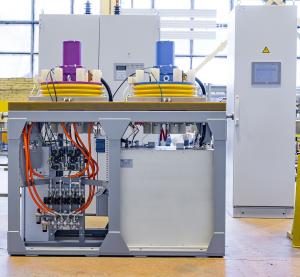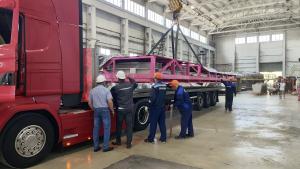Recent milestones in Russia
Russia continues to deliver in-kind components to the ITER project according to procurement arrangements signed with the ITER Organization. Some recent manufacturing news is highlighted below.
As part of in-kind contributions to ITER, Russia is supplying switching equipment, busbars, energy-absorbing resistors and control racks for the power supply and protection of the ITER superconducting magnets. Following the successful final design review (FDR 3.0) for switching devices, the D.V. Efremov Institute of Electrophysical Apparatus (JSC "NIIEFA") has begun the serial production of related components and systems such as the fast energy discharge system, control and diagnostics systems, the protective short-circuit device and others. In additional news, completed elements for the busbar system, operational switching resistors, and switching devices will leave the Efremov in up to 15 trailers for delivery to the ITER construction site by the end of the year.
Specialists from the Efremov are also actively collaborating with other ITER partners on the development of the first wall of the ITER blanket—a critical machine component that shields the steel vacuum vessel and superconducting toroidal field magnets from the heat and high-energy neutrons produced by fusion reactions. China and Russia are sharing the procurement of 225 enhanced heat flux first wall panels, designed for heat fluxes of 4.7 MW/m², while Europe is providing 215 normal heat flux first wall panels designed for heat fluxes of up to 2 MW/m². For all parties, first wall design, development and qualification has progressed in phases, as teams first manufactured and tested small-scale mockups, then semi-prototypes, and finally full-scale prototypes to prepare for series production. A full-scale prototype of enhanced heat-flux first wall panel with beryllium armour (pictured above)—corresponding to the original design for the first wall—has passed factory acceptance tests (high-heat flux, hydraulic and hot helium leak tests) and demonstrated the necessary technologies (welding, brazing, hot isostatic pressurizing) and production operations. Now that the project is switching from a beryllium first wall to a tungsten first wall, a qualification program has restarted this year at the Efremov. The team is also assessing boron carbide (B4C) as first wall coating to mitigate the tungsten contamination risk during plasma discharge.
Finally, Project Center ITER (Rosatom) just shipped a large 20-tonne frame to ITER (grey, in the pink frame above). The metal structure will evenly distribute the weight load of the first port plug test stand as it is used to carry out vacuum, strength, thermal and functional tests on some of the 30 port plugs that will seal off each tokamak port opening and carry diagnostics and heating system elements that are critical to efficient operation.
Three stands will be installed on site at ITER (in the former poloidal field coil test facility) to validate the port plugs after they are delivered and before installation on the machine. Each stand, organized within a series of open frames, is a complete system containing heating, vacuum, handling and control capacities that create conditions that are as close as possible to the actual operating conditions of the ITER machine.




